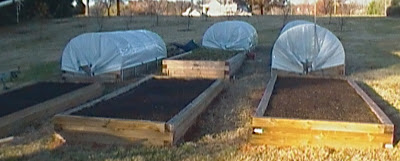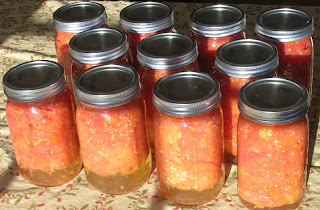I spent the week helping James drive from Utah to Quantico, home being the penultimate stop. It snowed yesterday, which has left a very nice couple of inches that look good on the lawns and trees, leaving the roads and driveways clear.
I was anxious to wake up this morning and see how my new cold frames had done. This was not a big snow, so the maximum stress on the engineering wasn't going to be tested. Still, I was anxious to see.
 Two of five cold frames looked very good. There was a little contraction on the oldest cover because the weight of the snow pulled the ends up. This left a small gap at either end where the plastic separated from the wood of the raised bed. I'm not sure what damage, if any, this might have done by letting colder air inside the bed. I certainly like the cut of the latest cover best. It seemed to keep things sealed nicely all around.
Two of five cold frames looked very good. There was a little contraction on the oldest cover because the weight of the snow pulled the ends up. This left a small gap at either end where the plastic separated from the wood of the raised bed. I'm not sure what damage, if any, this might have done by letting colder air inside the bed. I certainly like the cut of the latest cover best. It seemed to keep things sealed nicely all around.The other three beds did not do so well. Evidently, while we were traveling, there were strong winds and a tornado watch. I had strapped each of these three covers down on the ends, but didn't bother to secure the sides, even though I did have bungie cords there. I guess I assumed too much.

I believe the onions and garlic will do just fine. The photo below is of the onions (yellow of Parma in this case). In fact, the snow may have killed off some weeds, although I don't know that just yet.

 The garlic will also probably do just fine. I will re-attach the cover shortly and assume that the snow will just melt and keep the garlic and onions watered.
The garlic will also probably do just fine. I will re-attach the cover shortly and assume that the snow will just melt and keep the garlic and onions watered.I am most concerned with the cauliflower and Brussel sprouts. My experience in the past is that brassicas don't like to freeze. The broccoli were covered, so I am hopeful about them. But these others took it on the chin. I will re-attach this cover, too and will check them. If they are dead, I will know shortly. Perhaps, now that the damage is done, I will actually strap down the sides. But, this may be a catastrophe from which they won't recover and it will just be a loss.







.jpg)
.jpg)





































